- Game Versions
- Smash 3DS, Smash Wii U


I: Introduction | [INTR]
II: Parts of Timber | [PART]
III: Timber Variations | [VARS]
IV: Mechanics | [MECH]
Let's get on to it then, yeah?


The tree, as expected, has simple beginnings. It begins by planting a sapling. Afterwards, as any halfway-competent gardener will tell you, you have to water your sapling. Hitting it with enough water will cause it so quickly sprout into a large tree. It is at this point that the move has its most use. The player now has a potent launcher at their disposal in the axe, a means of defence against a wide range of attacks through their tree, and an emergency nuke by chopping down the tree, which also conveniently doubles as a potential source of health-restoring fruits or projectiles to add to the character's already expansive repertoire.
So, in short, you
- Plant a sapling
- Water the sapling
- Grow a tree
- Chop down your tree

Plant, water, chop (image from Sakurai's Daily Miiverse Posts)
So now it seems that you know enough about timber to call yourself Paul Bunyan, right? Wrong. The lesson in dendrology has just begun.


1. Sapling
You begin by planting a sapling. This can be done on any reasonably horizontal surface. Not much to say about that right now.
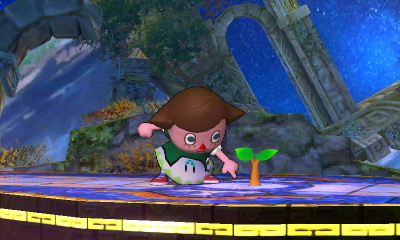
Yep, that seems to be a sapling
2. Watering Can
Using the move again has Villager use a watering can wherever they might be. During the move, you can walk, dash, and jump. The watering can proves useful every now and again because the water can push characters away and has nearly uncontested priority, meaning it will clank with pretty much any attack and cancel pretty much any projectile. Since it produces multiple "units" of water, even if it clanks with an attack, it will still go on to completion.
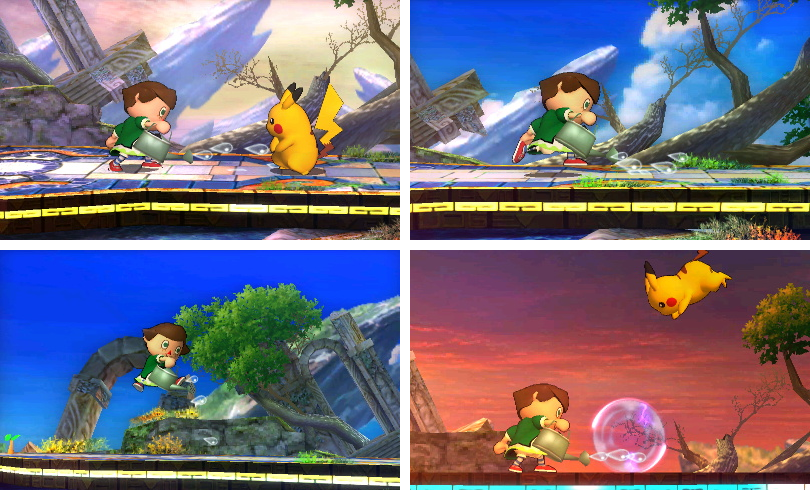
Push! Run! Jump! Remind Pikachu this isn't a Pokemon game!
3. Tree
Watering a sapling enough makes it grow into a mighty tree, which can take damage like any other fighter, allowing it to block moves (though it can't be launched). It sticks around either for a set amount of time, or until its HP is depleted, whichever comes first. It has an active hitbubble while sprouting that really hurts!

Yikes
4. Axe
Once you've got a tree on the field, using timber swings an axe. The axe is active as long as the tree remains on the field, and as long as the stump remains on the field after chopping the tree down (the stump's duration is tied to the other half's). The axe packs a serious punch, and the falling tree packs an even bigger one.
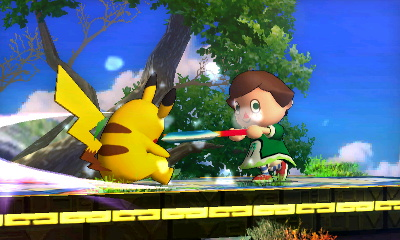
This is fine
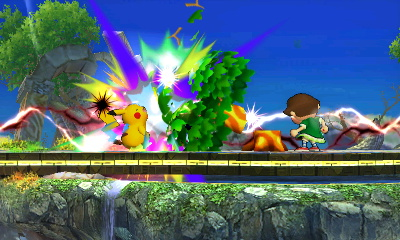
This is fine, too
5. Items
Sometimes, an item will fly out of a tree when it's been chopped down. It can either be a piece of wood, or fruit. The wood can be picked up or pocketed, and thrown as a projectile, dealing 3% damage. The fruit can be eaten to heal off damage. Also, wood can hit opponents while it's flying out of the tree, always dealing 8%, but apparently having variable knockback depending on the flight trajectory. I've heard that sometimes the tree will produce a Maxim Tomato but I can't confirm that.

...though you can pretend you're playing Pokemon when you're chucking stuff at Pikachu
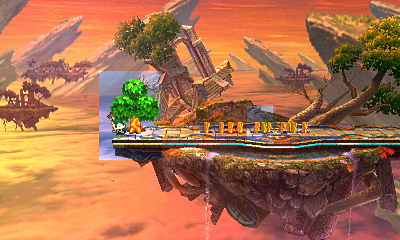
All possible flight distances for pieces of wood
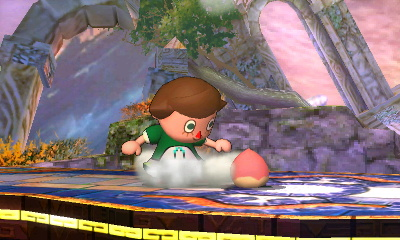
Yum

There are five different possible fruit that can fall out of a tree. Each fruit heals a different amount of damage, though no fruit seems to be rarer or more common than another. In any case, the chance that a fruit will be generated is extremely low, with only about 1/100 trees producing fruit (1%).


Anyway, like I already said, timber has three variations. These are:
- Timber (Standard)
- Timber Counter
- Super Timber
This is probably the variation that we are all most familiar with. It's the one you start off with, and is the most practical one if you plan on using the different parts of timber to actually try and net KOs or need heavy projectile management. Out of the three variations, this one produces the smallest trees. Aside from that though, there isn't much to say about this one.
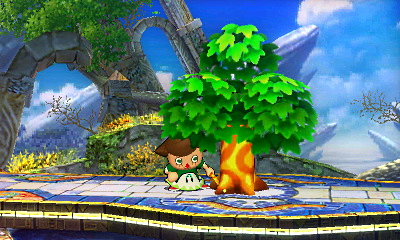
Basically the Ol' Reliable of trees
Easily the best timber variation due to the sheer amount of utility it provides. All other timber saplings are inert; however, the flashing Counter saplings continuously produce a hitbubble around themselves that both trips anyone unlucky enough to stroll over them and hits for 2% damage. When watered, a sapling grows into a tree that flashes red and shakes whenever it is hit, producing a "counter shockwave" that hits for 5% damage. This can be induced by both your opponents' and your own attacks! For all intents and purposes, this is the variation you should be using.
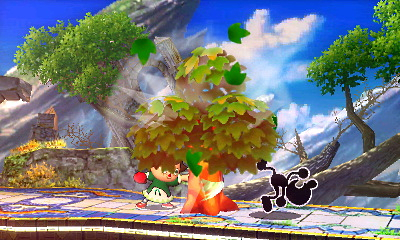
Basically the Wobbuffet of trees
Large and in charge, Super Timber maximises every part of the move's power. The watering can has the greatest range and has the highest weight-based knockback, the axe deals the most damage and launches the farthest, and the tree itself is as terrifyingly powerful as a blow from the likes of Bowser. There's just one catch, though: all of it takes painfully long to pull off. The sapling has the longest planting time, and the axe moves as though you were chopping through molasses. In addition to this, second for second, this variation lasts the shortest amount of time, inexplicably so. The sapling and tree don't stick around as long as their well-adjusted and strung-up brethren. Because of this, Super Timber doesn't see much use, and is generally agreed to be the worst of the variations.
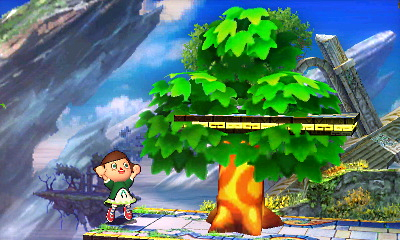
Basically the Giant Sequoia of trees that aren't Giant Sequoias
Saplings
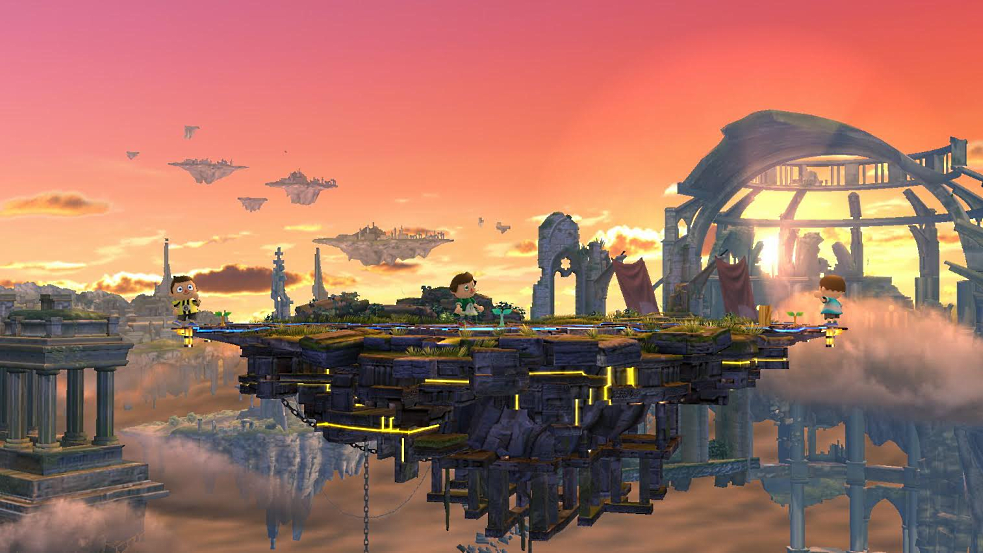
Left: Standard Sapling | Center: Counter Sapling | Right: Super Sapling
Watering Cans
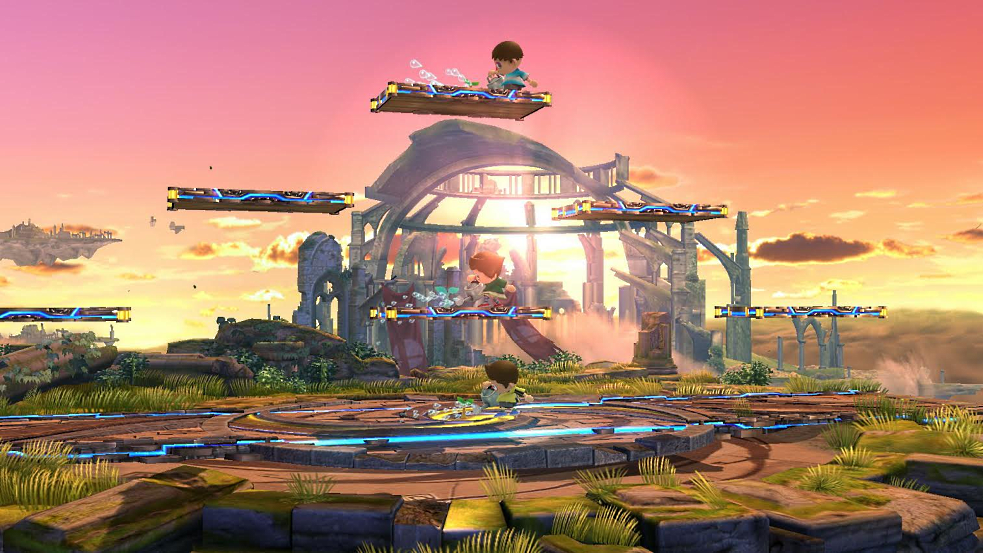
Top: Super Watering Can | Center: Counter Watering Can | Bottom: Standard Watering Can
Trees

Left: Standard Tree | Center: Counter Tree | Right: Super Tree
 IV: Mechanics [MECH]
IV: Mechanics [MECH]



Now, to delve into the finer points of timber. Timber has a lot of interesting mechanics, mostly pertaining to the tree itself.

Saplings and trees operate on a system I've decided to call longevity, because it dictates how long they last on the field of battle. Longevity is further comprised of two independent mechanics: a lifespan system, and an HP system.
- Lifespan: Both trees and saplings have lifespan systems. A tree or sapling's lifespan is a predetermined amount of frames, the amount of which varies between the customs. Near the end of its lifespan, a tree will begin to brown and wither, and at the end, shrink away. Saplings simply disappear from the field. Additionally, Counter Trees and Counter Saplings will stop flashing once they've begun the withering process. While withering, the next move in timber is available, but will have no effect on the tree/sapling. For example, watering a withering sapling will not cause it to grow, and swinging an axe at a withering tree will simply go through it as though it weren't there.
- HP: The HP system is exclusive to trees. Trees have set amounts of HP, though the amount varies between the customs. HP is subtracted from a tree each time a damaging hitbubble collides with its hurtbubble, reducing its HP by however much damage the hitbubble would have dealt under standard conditions. Once a tree's HP has been completely depleted, it will shrink away, though noticeably more quickly than when it withers.
Lifespan and HP Values by Variation
Standard Sapling||14S / 840F
Standard Tree|30%|11S / 660F
Counter Sapling||16S / 960F
Counter Tree|15%|15.5S / 930F
Super Sapling||10S / 600F
Super Tree|50%|9.5S / 570F
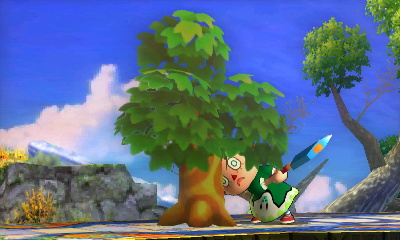
Not today, old friend...

Saplings and trees also have multiple ownership mechanics. These can govern both hitbubbles and timber order, and are separate from each other.
- Pre-axe hitbubble ownership: Pre-axe hitbubble ownership is dependent on whoever watered a sapling last. For example, if Villager A plants a Counter sapling, and Villager B waters it (but not enough for it to sprout), then the sapling will no longer make Villager B trip, and will instead trip Villager A. If Villager B then waters it enough to make it sprout, the sprouting hitbubbles will be able to hit Villager A. Furthermore, Villager B will be unaffected by the Counter hitbubbles, while Villager A won't. Conversely, if Villager A full waters the sapling after Villager B took ownership of it, it will swap back to Villager A
- Post-axe hitbubble ownership: This only covers a tree's falling hitbubbles. If Villager A grows a Counter tree and Villager B chops it down, the tree will be able to hit Villager A. However, axes will not swap the tree's Counter hitbubbles, meaning each time Villager B chops at Villager A's Counter tree, they will be hit by the Counter
- Original ownership: Original ownership deals with timber order. This type of ownership cannot be swapped under any circumstances, and as stated before, is thus unaffected by the status of a tree or sapling's other ownerships. As the name implies, this will always belong to whoever originally planted a sapling. It is tied to the state of the "active" portion of timber; that is to say, the part that is present on the stage as either a sapling or a tree. If Villager A plants a sapling, and Villager B full waters it, Villager A will still be forced to follow the usual order of timber, due to original ownership. Thus, Villager A will now use the axe when inputting timber, despite the tree no longer belonging to them. Alternatively, if Villager B had only watered it enough to take ownership of the sapling, then Villager A would still use the watering can when inputting timber.

Tree priority is the term I've coined to refer to the interaction between multiple trees or saplings.
Tree priority hinges on a peculiar mechanic involving the collision of a tree's hitbubbles with other trees' hurtbubbles. When this happens, the victim trees automatically lose any and all of their remaining HP, causing them to shrink away.
For example, Villager A has a Standard tree up. Villager B plants, waters, and chops down a Super tree. The Super tree's strong falling hitbubble hits the Standard tree, which still has 30% HP. Despite the hitbubble having a base damage of 27%, which should leave the Standard tree standing with 3% HP remaining, the Standard tree will shrink away, as though it had lost all of its HP.
In another example, Villager A has a Super tree up. Villager B plants and waters a Counter sapling, then causes it to counter, which hits the super tree. Despite still having 45% HP left, the same thing will happen: the Super tree will shrink away.
This allows a simplification of tree priority into two general rules:
- If two saplings are close enough to each other such that one would be able to water them both at once, and the trees would collide, then the sapling closest to the watering Villager will take priority
- If a sapling (tree 2) is planted at the base of an existing tree 1 and watered, then tree 2 will take priority
I need to stress that these are general rules. There will be times when particular placement and spacing will cause trees to not follow these rules when interacting. However, even in those situations, hitbubble collision would still work the same way.
